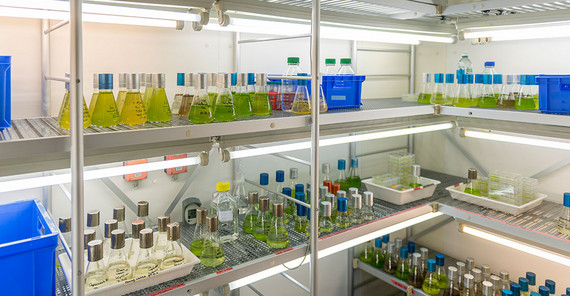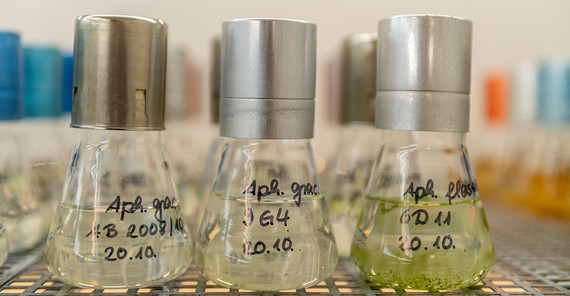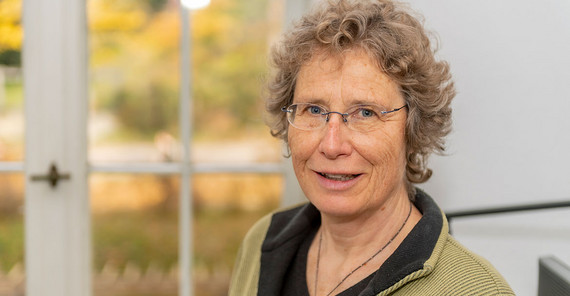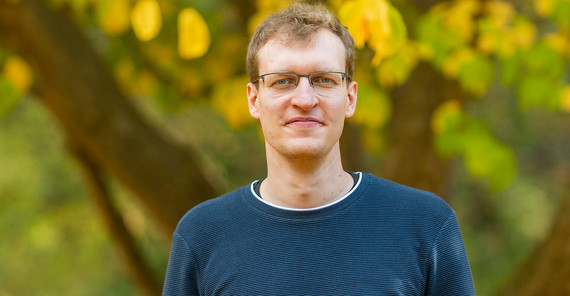There is a reason why they take good care of algae and zooplankton at the Institute of Biochemistry and Biology. They are important model organisms that represent the basis of natural food webs in waterbodies. With their help, researchers want to understand how different species live together in an ecosystem, how they support or inhibit each other, how they eat and are eaten, or how they reproduce. In the Priority Program “DynaTrait”, funded by the German Research Foundation (DFG), they are primarily investigating the characteristics of organisms – the “traits” – which can be amazingly variable.
Symbiotic communities are constantly changing
Highly simplified, the food web in a natural lake looks like this: At the lowest level, microalgae, known as phytoplankton, convert solar energy into biomass through photosynthesis. The algae are the food source for the zooplankton, which include water fleas, rotifers, ciliates, and other animals, most of which are less than one millimeter in size. The zooplankton are eaten by small fish, which in turn are food for large fish.
However, such a food web is not a static but an extremely dynamic structure. Depending on the season, temperature, nutrient supply, and other environmental conditions, the density of organism fluctuates greatly, species compete with each other for resources and permanently adapt to the various environmental conditions. At each level of the food web, numerous species interact with each other, each with very different characteristics and capabilities. The algae and zooplankters in the climate chamber are only a small but very important component of the entire aquatic food web, which the researchers are using to study the mechanisms in such a complex system.
Dr. Klauschies points at a glass flask containing a somewhat turbid liquid. If you look at the contents of a drop of water taken from this flask under the microscope, there are lots of little dots scurrying around. If you look even more closely, you will recognize the rotifer Cephalodella: a tubular, transparent animal with a ciliated ring at the top, which is used to swirl food into its mouth. In a laboratory culture, Cephalodella leads a carefree life. It is regularly supplied with algae of just the right size and structure. In nature, things look quite different. Here, the rotifer must compete with other species for food, is itself prey to larger organisms and does not always have the perfect food available.
Under optimal conditions, this species exists in large numbers. When the conditions are not as good, the population size decreases. Dr. Klauschies takes a closer look at these cycles. He does this on the computer, where he uses mathematical models to replicate the population life cycles of different species, and also experimentally in the laboratory, where he tests how rotifer’s growth rates develop at different temperatures, food sources, and in presence of a competitor.
Algae have defense strategies
“In classical ecological theory, it is assumed that organisms have fixed traits,” explains group leader Prof. Dr. Ursula Gaedke. “But that’s not the case, because individual species are not as rigid in their characteristics as is often assumed. Predators and prey adapt to each other.” Some algae, for example, may develop long, spine-like appendages to avoid being eaten. If there are many zooplankton, such as rotifers that like eating these algae, they can still survive thanks to their defense mechanisms. However, the strategy comes at a price: Those that defend themselves with spines or other means reproduce more slowly and have fewer offspring. And predators also respond to their prey: They adjust their size to eat larger particles. Predators and prey are constantly upgrading and are sometimes very flexible in their strategies and traits. In the “DynaTrait” program, the researchers are tracking down these diverse adaptation mechanisms and want to find out how this flexibility affects ecosystem functions and population dynamics.
Since 2014, more than 60 scientists from all over Germany have been working on these questions in over 20 subprojects. They are evaluating long-term data from Lake Constance, cultivating different species of phytoplankton and zooplankton together in long laboratory experiments, determining growth rates of individual species under different conditions and modeling food webs and their individual building blocks on the computer. They exchange their results with each other and thus gradually approach an overall picture. “We find such an enormous diversity of species in nature. How does this actually happen? Why can so many species coexist with each other?” These are the fundamental questions behind the research projects, Prof. Gaedke explains.
How well an ecosystem can adapt to changing conditions or survive disturbances also depends on how many species are present. “Biodiversity leads to stability,” she says, describing an important observation from the work so far, which will be examined in more detail in future research. If, for example, one or more species fail – due to disease, heat, or heavy rains that wash too many nutrients into water body –this can become a major problem for a species-poor system. Losses at the lower end of the food chain quickly spread to the upper levels. If there is less zooplankton, for example, fish will no longer find sufficient food. So, the problem also has an economic dimension.
In intact, diverse ecosystems, these strong fluctuations do not exist. If one species fails, another one better able to cope with the conditions immediately steps in. In the model simulation, the researchers compared how a very species-poor and a species-rich community of algae and zooplankton reacted to a strong nutrient input. While an algal bloom developed in the species-poor community, which can cause fish mortality and other problems in waters, these developments did not occur in the diverse community. Here, various zooplankton species were able to regulate the algae well and prevent mass proliferation.
Basic ecological questions are examined with model organisms
The researchers now want to verify individual results from the modeling under experimental conditions in the laboratory. The experiments will also show whether the mechanisms found in the model occur and are relevant in natural systems. Doing so, they are taking advantage of the fact that phytoplankton and zooplankton are very good model organisms that can be easily cultivated and quickly reproduced in the laboratory. They can be used to investigate fundamental ecological questions that can also be transferred to other ecosystems. The experiments will test, for example, whether changes in temperature influence the coexistence of organisms or how salt stress affects the growth of individual species. “What do population dynamics look like? Under what conditions can species coexist? And when do systems become unstable?” Dr. Klauschies wants to answer these questions with his experiments.
He knows from his own experience that it is not easy at all to recreate nature in the laboratory. If several species grow together in an experiment, individual species always disappear unintended. “In the lab, species compete more strongly. In nature, on the other hand, various mechanisms work together to enable coexistence,” he explains. So, it takes a lot of intuition and patience to set up an experimental laboratory system with several species. However, Dr. Klauschies finds the close interlocking with the modeling just as important. “That helps a lot with going through other options that you can’t reproduce in the lab.”
The Researchers
Prof. Dr. Ursula Gaedke studied biology at the University of Oldenburg and applied statistics at Oxford University. Since 1999, she has been Professor of Ecology and Ecosystem Modeling at the University of Potsdam. Since 2014, she has been head of the DFG priority program DynaTrait.
Mail: ursula.gaedkeuuni-potsdampde
Dr. Toni Klauschies studied biology and mathematics for the teaching profession at the University of Potsdam. Since 2016, he has been researching the coexistence of predator-prey systems and the influence of global changes on diverse communities in the project “DynaTrait”.
Mail: toni.klauschiesuuni-potsdampde
The Project
DynaTrait (Flexibility matters: Interplay between trait diversity and ecological dynamics using aquatic communities as model systems) is a priority program of the German Research Foundation (DFG). It investigates how the adaptive capacity of organisms affects food webs and ecosystem functions.
Participating: GEOMAR Helmholtz Centre for Ocean Research Kiel, Max Planck Institute for Evolutionary Biology, University of Potsdam, Carl von Ossietzky University of Oldenburg, Ruhr University Bochum, Leibniz Institute of Freshwater Ecology and Inland Fisheries, Technische Universität Dresden, Helmholtz Center for Environmental Research, University of Konstanz, Osnabrück University, University of Cologne, Ludwig-Maximilians-Universität München, Alfred-Wegener Institute, Helmholtz Center for Polar and Marine Research, University of Duisburg-Essen, Helmholtz Center Hereon, Leibniz Center for Tropical marine research
Duration: 2014–2024
This text appears in the university magazine Portal Wissen - Zwei 2023 „Exzellenz“ (PDF).




